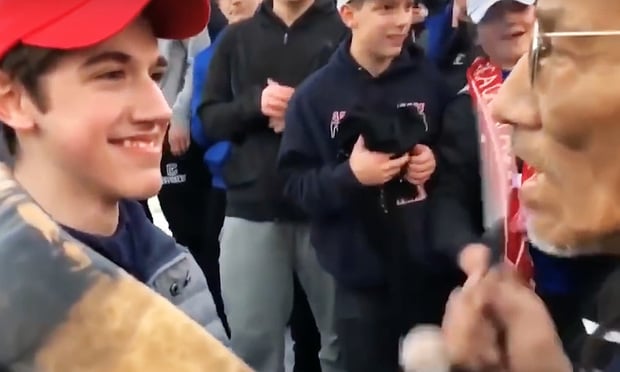CNN Moves to Dismiss Suit by 'MAGA' Hat-Wearing Teen in Viral Video
The CNN suit is one of three multimillion-dollar suits filed on behalf of Covington Catholic High School teenager Nicholas Sandmann against major news media organizations that reported on Sandmann's encounter with a Native American activist on the National Mall in Washington, D.C.
May 22, 2019 at 11:57 AM
5 minute read
 Nicholas Sandmann (left) facing Native American activist Nathan Phillips at the Lincoln Memorial on Jan. 18, 2019. (Photo: YouTube)
Nicholas Sandmann (left) facing Native American activist Nathan Phillips at the Lincoln Memorial on Jan. 18, 2019. (Photo: YouTube)
CNN is challenging a $275 million defamation suit stemming from its coverage of a viral tweet featuring a Kentucky teenager's encounter with a Native American protester and the media firestorm that followed.
The cable network, headquartered in Atlanta, contended in a motion to dismiss the lawsuit by Kentucky teenager Nicholas Sandmann that the majority of allegedly defamatory statements attributed to CNN are either not about Sandmann, are statements of opinion that do not rise to the level of actionable libel, or are true.
The suit—one of three multimillion-dollar defamation claims Sandmann has brought in federal court Kentucky—sprang from media coverage of a photo of Sandmann in a face-to-face encounter with Native American protester Nathan Phillips on the National Mall in Washington, D.C., last January.
Sandmann's lawyers are Atlanta attorney Lin Wood and his Kentucky co-counsel Todd McMurtry. CNN is represented by a legal team from the Washington, D.C., offices of Ballard Spahr led by Charles Tobin, and Cincinnati firm Keating Muething & Klekamp.
Sandmann and classmates from Covington Catholic High School in Kentucky were in Washington to attend the annual March for Life when the teen was photographed in a face-to-face encounter with Phillips.
Phillips and other Native Americans were attending the Indigenous Peoples March on the Mall.
The tweeted snapshot that sparked the coverage—accompanied by often harsh commentary about Sandmann and his fellow students—depicts Sandmann smiling and wearing a red “Make America Great Again” hat while surrounded by other teenage boys as he stood face-to-face with Phillips, who was beating a drum and chanting.
A nearby group of Black Hebrew Israelites that engaged in often raucous and offensive speech directed at the students as well as the presence of other Native American activists also factored into interpretations of the encounter and its aftermath, once the episode spilled onto the internet.
“Many have come away from the events themselves and the resulting media coverage with strong, diverging views about what really happened,” CNN lawyers said in their motion to dismiss Sandmann's complaint.
CNN contends it first reported on the teen's encounter and its viral aftermath after the Catholic diocese in Kentucky where Sandmann's school is located issued a statement condemning the students' alleged mistreatment of Phillips—a statement the diocese later largely retracted. CNN said its initial reporting didn't identify Sandmann, even though some statements lifted from those news reports have been labeled by Sandmann's lawyers as defamatory.
CNN has acknowledged that some of its reports said the teens were “taunting” or “mocking” Phillips—descriptions that Wood has challenged as false.
CNN also contended in its motion that its journalists took care “to note additional facts as they developed and to share the perspectives of eyewitnesses and participants as they came forward.” That included publishing a statement that Sandmann released after he returned to Kentucky and identifying him as the teen in the viral photo.
CNN claimed that although Sandmann's suit “essentially takes issue with any and every point of CNN's reporting,” Sandmann “as a matter of law cannot show that CNN's reports reasonably convey any false and defamatory implications about him.”
But Sandmann's complaints against CNN, The Washington Post and NBC Universal contend that media reports subjected him to international ridicule because he is white, Catholic and was wearing a ball cap with Donald Trump's presidential campaign slogan “Make America Great Again.” The suits also depict the teen as a victim of media and cyber-bullying.
Sandmann has sued the Post for $250 million and NBC for $275 million. The Post has filed a motion to dismiss the case, arguing, “It was neither false nor defamatory … to report the comments of eyewitnesses, including the only participants who were speaking publicly about the matter on the day that videos of the event went viral on the internet. Newspapers are often unable to publish a complete account of events when they first come to light. Stories often develop over time, as more witnesses emerge.”
Wood said in a response to the Post's motion that the newspaper “was obliged to use reasonable care to ensure its coverage was accurate in the first instance, especially given the magnitude of the resulting public hatred, ill will, and contempt directed at Nicholas, a minor” that Wood insisted “was forseeable” in the current “politically charged and polarized climate.”
Wood similarly argues that CNN “made Nicholas the face of evil,” even when its reporters and commentators didn't identify the teen.
“Nicholas's face is dominant, and he became the focus of the reporting,” Wood said. “There is no doubt that Nicholas was identified and portrayed as the face of racist misconduct.”
Wood also contended that the Post and CNN “negligently republished false and defamatory statements of third parties.”
He also said that, under Kentucky law, accurately republishing a lie is not a defense. “To the contrary, it is actionable where, as here, CNN failed to exercise reasonable care before republishing the lies and inaccurate statements,” he said.
“A simple review of the video of the incident available online would have established that the third parties were either lying or horribly uninformed or misinformed,” Wood added. “I think Nicholas' complaint sets forth a plausible cause of action sufficient to defeat the motion to dismiss where the court must accept as true the detailed allegations in the complaint.”
Read More:
Judge in CNN, Washington Post Libel Case Is No Stranger to Free Speech Fights
This content has been archived. It is available through our partners, LexisNexis® and Bloomberg Law.
To view this content, please continue to their sites.
Not a Lexis Subscriber?
Subscribe Now
Not a Bloomberg Law Subscriber?
Subscribe Now
NOT FOR REPRINT
© 2025 ALM Global, LLC, All Rights Reserved. Request academic re-use from www.copyright.com. All other uses, submit a request to [email protected]. For more information visit Asset & Logo Licensing.
You Might Like
View All
40% Contingency: A New Ruling Just Cost This Plaintiff Team $827K in Legal Fees
6 minute read
'David and Goliath' Dispute Between Software Developers Ends in $24M Settlement

Trending Stories
Who Got The Work
Michael G. Bongiorno, Andrew Scott Dulberg and Elizabeth E. Driscoll from Wilmer Cutler Pickering Hale and Dorr have stepped in to represent Symbotic Inc., an A.I.-enabled technology platform that focuses on increasing supply chain efficiency, and other defendants in a pending shareholder derivative lawsuit. The case, filed Oct. 2 in Massachusetts District Court by the Brown Law Firm on behalf of Stephen Austen, accuses certain officers and directors of misleading investors in regard to Symbotic's potential for margin growth by failing to disclose that the company was not equipped to timely deploy its systems or manage expenses through project delays. The case, assigned to U.S. District Judge Nathaniel M. Gorton, is 1:24-cv-12522, Austen v. Cohen et al.
Who Got The Work
Edmund Polubinski and Marie Killmond of Davis Polk & Wardwell have entered appearances for data platform software development company MongoDB and other defendants in a pending shareholder derivative lawsuit. The action, filed Oct. 7 in New York Southern District Court by the Brown Law Firm, accuses the company's directors and/or officers of falsely expressing confidence in the company’s restructuring of its sales incentive plan and downplaying the severity of decreases in its upfront commitments. The case is 1:24-cv-07594, Roy v. Ittycheria et al.
Who Got The Work
Amy O. Bruchs and Kurt F. Ellison of Michael Best & Friedrich have entered appearances for Epic Systems Corp. in a pending employment discrimination lawsuit. The suit was filed Sept. 7 in Wisconsin Western District Court by Levine Eisberner LLC and Siri & Glimstad on behalf of a project manager who claims that he was wrongfully terminated after applying for a religious exemption to the defendant's COVID-19 vaccine mandate. The case, assigned to U.S. Magistrate Judge Anita Marie Boor, is 3:24-cv-00630, Secker, Nathan v. Epic Systems Corporation.
Who Got The Work
David X. Sullivan, Thomas J. Finn and Gregory A. Hall from McCarter & English have entered appearances for Sunrun Installation Services in a pending civil rights lawsuit. The complaint was filed Sept. 4 in Connecticut District Court by attorney Robert M. Berke on behalf of former employee George Edward Steins, who was arrested and charged with employing an unregistered home improvement salesperson. The complaint alleges that had Sunrun informed the Connecticut Department of Consumer Protection that the plaintiff's employment had ended in 2017 and that he no longer held Sunrun's home improvement contractor license, he would not have been hit with charges, which were dismissed in May 2024. The case, assigned to U.S. District Judge Jeffrey A. Meyer, is 3:24-cv-01423, Steins v. Sunrun, Inc. et al.
Who Got The Work
Greenberg Traurig shareholder Joshua L. Raskin has entered an appearance for boohoo.com UK Ltd. in a pending patent infringement lawsuit. The suit, filed Sept. 3 in Texas Eastern District Court by Rozier Hardt McDonough on behalf of Alto Dynamics, asserts five patents related to an online shopping platform. The case, assigned to U.S. District Judge Rodney Gilstrap, is 2:24-cv-00719, Alto Dynamics, LLC v. boohoo.com UK Limited.
Featured Firms
Law Offices of Gary Martin Hays & Associates, P.C.
(470) 294-1674
Law Offices of Mark E. Salomone
(857) 444-6468
Smith & Hassler
(713) 739-1250







